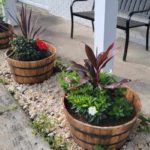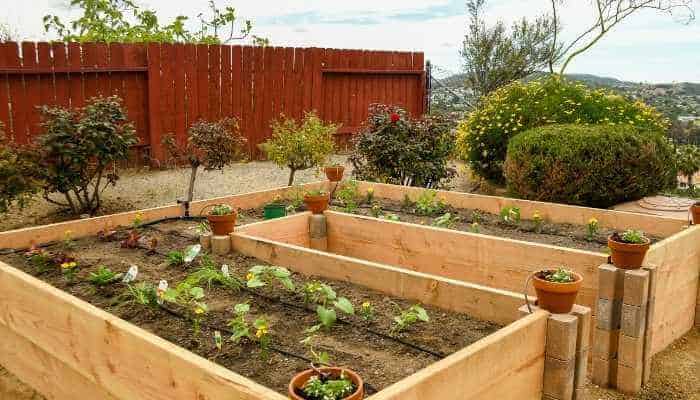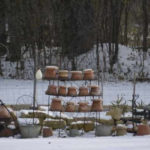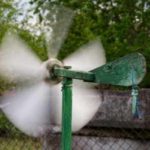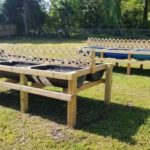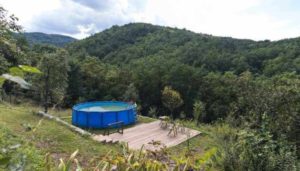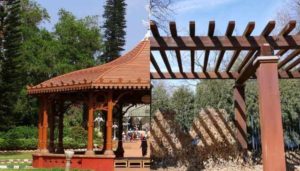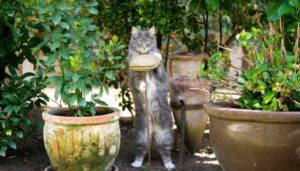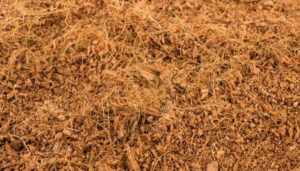People have come to realize that gardening using raised beds can be much easier than traditional gardening. It provides the gardener with control over what’s in the soil, easier weeding, and the ability to garden even where there is hard soil.
But what should you use as the bottom base material in your raised garden beds?
The bottom of a raised garden bed should have a layer of cardboard, newspaper, burlap, or hardware fabric for good drainage and for slowing down weeds. Then, it should have a layer of organic matter such as grass clippings, leaves, untreated wood chips, or straw for compost.
The layer on the bottom of your raised garden bed can be a weed deterrent. Since you have the choice of what material to use it’s up to you. Perhaps you have something readily available that’s convenient. But what if you don’t – which material will serve you best?
I’m going to go over the best materials to put in the bottom of a raised garden bed, but keep in mind this is for beds that have been placed directly on the ground. If you place your raised garden bed on a deck or on a flat roof, you would definitely need to find something that would protect that surface.
Why Is Cardboard the Best Material to Use at the Bottom of a Raised Garden Bed?
Other than being compostable and safe for use as a base layer in your garden, cardboard also provides a relatively hard barrier for weeds. I know from experience that when we used cardboard, it took a year for the first bermudagrass to show up on the inside of our raised garden beds. That kept the weed issue much more controllable.
Cardboard is made of cellulose, which is an organic matter that will decompose over time. It will eventually go back into the land and help the ground become more fertile. It also is a favorite of earthworms, and earthworms are a necessity for healthy, naturally aerated soil. Because plastic won’t break down, be sure not to use plastic-coated cardboard or cardboard that has a lot of plastic shipping tape on it.
Cardboard is relatively easy to come by. You can use boxes you’ve received here and there, or you can go to any retail store and ask for some cardboard boxes. Even if they compact their cardboard, they may have some available. Therefore, it’s free!
Is Newspaper a Good Material for the Bottom of My Raised Garden?
If you plan on using the newspaper in the bottom of your raised garden bed to keep weeds under control, it’ll be best to layer the newspaper. The material is just too thin to use only one layer, in my opinion. Use 6 – 10 layers of newspaper to come close to matching the weed control of cardboard. To keep that paper under control until you can get the compost or soil in, you may want to also place a thin layer of mulch right on top of it.
Like cardboard, a newspaper is also made up of cellulose – an organic material. That means it will also break down over time, enriching the soil around it. You don’t have to worry about the type of newspaper, as it should all be compostable. Also, you can usually get newspapers for free from newspaper offices or from other people who have them available.
Can I Use a Natural Fiber Like Burlap in the Bottom of My Raised Garden?
Absolutely. This is another natural fiber. It’s made from the fibers of the jute plant. The plant fibers can break down while also providing your raised garden bed a layer of protection from invasive weeds and allowing the flow of water for drainage. Burlap can discourage weeds for at least a season of god planting.
It does decompose quickly and can fray at the edges very easily, so cutting it for placing might be a little more annoying than you like. But if you purchase burlap in the largest bag form you can get, maybe you won’t even need to cut it?
Can I Use Mulch on the Bottom of My Raised Garden?
Mulch can be a good base for your raised garden beds, especially if those beds are tall (over 2 ½ feet). Wood-chip mulch that hasn’t had chemicals added works best. If it’s layered on the bottom in about a 2-inch layer it can deter weed growth, help with drainage, and add organic matter to your bed.
If you also mulch the top of any type of bed, the mulch actually pulls moisture through it to the soil, helping plants retain the moisture in drought conditions. It helps control soil temperatures and if you have at least a 3 to 6-inch layer on top of your soil, it deterred weed growth here, too.
Can I Use Old Carpet for My Raised Garden Beds?
Old carpet can definitely be used to keep weeds from growing into your soil. However, there are some drawbacks. For one thing, do you know what kind of chemicals might be in that carpet before you use it? You don’t want this to leech into your soil. Be sure it’s made of a natural material if possible with no chemicals.
Also, some weaves are so tight that they can actually slow down drainage. If you use carpeting or carpeting scraps, it has a very tough bottom to it, which can hinder the root growth of some vegetables. So be sure the raised garden is deep enough to allow for these vegetables.
You can also use carpeting (so long as it’s porous) to place on top of your raised garden beds to eliminate weeds on top as well. It’s part of winterization and soil solarization. When the bed isn’t in use, it can be spread over the top to kill off unwanted weeds. Because it’s porous, the soil won’t overheat and water can get through, so the beneficial microbes and worms will thrive.
What Makes Hardware Fabric a Good Choice for a Raised Garden?
This was a choice that I had never heard of. I’m considering it in addition to cardboard for a friend’s outdoor beds. Why? Because even though hardware fabric isn’t great with keeping out weeds, it definitely works well to keep out pests like rodents. My friend has a problem with moles and other burrowers.
Because the fabric is woven with metal wires, nothing can chew through it, but for some reason, it doesn’t stop earthworms nor does it do so well with keeping weeds from growing around the weave. For that reason, you should consider using this material in addition to something else that’s more effective against weeds.
Should I Use Landscape Fabric at the Bottom of My Raised Garden?
Maybe not. Landscaping fabric isn’t always everything the manufacturers want you to believe. It does hamper weeds, but a lot of weeds simply keep growing beneath it until it reaches the side or finds a weak spot. Removing weeds that have root systems attached to the fabric can be a nightmare. I know from experience.
It prevents weed seeds from germinating in your soil when placed around plants on top of the soil. Usually, you’ll find it around ornamental plants in beds covered by a layer of mulch or in gardens with crops popping out of it. However, that doesn’t stop soil from getting on top of the sheeting thanks to erosion, wind, and water passing through. Weeds can still grow in this kind of environment.
Landscape fiber is usually made from recycled material such as linen or polyester. Yes, polyester is a form of synthetic material – in other words, plastic. With so much environmental waste that’s plastic, I for one don’t want to add more to it by using this stuff.
This fiber is supposed to be porous and therefore water in the raised bed will transport easily. However, some of the tougher versions actually do not let much water through, and therefore your plants may dry out if it’s used on top, while it may hold too much water on the bottom.
If this material deters water and heats up the soil beneath it, it is a barrier to healthy biodegrading within the soil. No beneficial microbes or earthworms can be bad. The soil isn’t aerated by the worms and their waste isn’t left behind to develop and attract good microorganisms that keep a garden healthy.
Most landscapers and even agro-science have found that a 6-inch layer of wood chip mulch can be just as effective as landscaping fabric.
Are Stones or Pebbles a Good Material for the Bottom of a Raised Garden Bed?
Stones and pebbles are a natural base that virtually never decomposes. So it’ll always be there to provide a barrier between the ground and your plants. However, you have to find them first – or buy them. And that can be expensive, especially if you have a lot of beds.
Loose stone isn’t particularly good at keeping weeds from getting into your beds. As surprising as this may seem, a rock barrier doesn’t provide very good drainage when compressed with garden soil. So this isn’t the best choice for base material.
What Materials Work Best Over the Bottom Layer of Material in My Raised Garden Bed?
You should place some sort of easily-drained organic material over your base material. The organic material will turn into compost, later enriching the soil beneath your plants.
Old wood or dried wood can be used. All the way down to twig-sized is fine. In taller beds, some people even use logs. It’ll take that plenty of time to decompose and the drainage is excellent.
Straw used as mulch both in the bottom of a raised garden bed and on top helps the soil to retain moisture and acts as another layer in preventing weeds. Three to four inches of this material is recommended on the bottom.
Dead leaves are actually an amazing weed deterrent that can last for around 6 months before breaking down enough to allow weeds to meander through them. But think of all the rich soil you get from the breakdown of dead leaves. And they are generally easy (and free) to find no matter the region you happen to live in.
What Materials Should I Avoid as a Base for My Raised Garden?
Treated Wood
Remember that most treated lumber (and sometimes you don’t realize that mulch made from outside sources) contains chemicals that may be harmful to your plants and to the environment. If it’s used as mulch or even as the lumber you use to make your raised garden bed, the toxic chemicals can leech into the soil.
Plastic
Plastic materials definitely hamper weed growth. Unfortunately, like carpeting, plastic can slow down the drainage and actually completely hamper it. Plus, we already have so much plastic in the environment and we don’t know what might leech into the ecosystem from its very slow breakdown. I just wouldn’t use it.
In Conclusion
I suggest that if you’ve not placed your beds, you place the base materials first, then you put the raised garden beds over them. Then, use your organic materials in the bottom, and finally your soil and compost mixture.
Once you’ve filled those beds with enough soil and compost to keep them in place, you can use a mulch to cover any overhang on the outside perimeter of your beds. This will reduce weed growth.
You have several very good options that are also free or cheap to use as the base for your raised garden bed, so find the one that’s convenient for you and get to growing!

